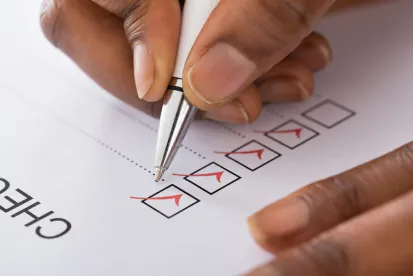Checklists. Pilots use them before takeoff to ensure that critical items are not forgotten. Doctors use them for simple patient procedures as well as major operations to avoid mistakes. In fact, we all use checklists—it’s human nature.
In our hectic, distraction-filled lives, all kinds of lists help us get organized. Whether it’s a grocery list or step-by-step instructions, whether it’s written down on paper or on a smartphone, when we want to focus and do something well (and completely), we make a list.
Because of their usefulness and ubiquity, checklists are relatable to jurors from all backgrounds. That’s why, in most cases, an electronic checklist is one of the most effective trial graphics you can use.
Using Checklists at Trial
A checklist is ideal to use with your expert during direct examination. Not only does the list direct your jury to the main points you want to make from the witness’ testimony, but it also focuses your expert and provides an organized method to walk through and teach a complicated procedure or process during testimony.
Judges can also benefit from a checklist graphic. The use of any trial graphics during a bench trial is often dismissed because we assume the judge will automatically understand all the issues in a case. However, just like jurors, a judge learns best by hearing and seeing at the same time. In the same way a checklist can focus the jury’s attention, it can also help the judge concentrate on your important case facts and avert distraction during days of testimony.
The same caveats apply for using a checklist as for any other graphic. You must announce to the court that you will be presenting slides with a checklist that the witness has created based on their expert opinion and/or report. Additionally, make sure you have the ability to change the wording in a few seconds if opposing counsel objects.
How to Create an Effective Checklist
In order to produce the most impactful electronic checklist, there are a number of key points to keep in mind:
-
LANGUAGE
The language you use should be simple. Keep jargon or terms of art to an absolute minimum. Remember, the goal of a list is to simplify and focus the information for the court. Technical terminology defeats that purpose.
-
WORD ECONOMY
When it comes to a checklist, the rules of proper English can be ignored. Sentence fragments work just fine. If you are going to use punctuation (question marks or periods) at the end of each item, make sure you are consistent.
Also, keep in mind the courtroom setup when designing your demonstratives. For example, when the jury box is at least 10 feet from the court’s projection screen or TV, your font size needs to be a minimum of 20 point. If you need room for more words, use more slides.
-
SIMPLICITY
While using PowerPoint will give you a tremendous amount of flexibility and creative potential, don’t go overboard. Your checklist needs to be an extension of the written version and shouldn’t distract jurors.
This simplicity extends to your animations as well. Each item should be brought up one by one, with a very simple animated wipe or fade.
-
CHECKMARKS
A very effective way to use a checklist during direct or cross examination is to check the appropriate box during the witness’ testimony. If done correctly, jurors will see everything you show on the list get checked off alongside the witness’ testimony by the end of their examination.
If you do use a checklist during cross, you will need the flexibility to check YES or NO. With PowerPoint, those boxes can be set up to select one or the other without having to move in an ordered animation sequence.
-
COLOR AND IMAGERY
As with all trial graphics, make sure the color scheme of your checklist matches the color scheme of your other graphics. Consider using a related icon. For example, in a product defect case, you could use an image of the product at the top of the YES or NO boxes.
Similarly, if appropriate, add a picture of the witness. This works especially well in closing arguments when summarizing a particular witness’ testimony.

Above are classic examples of checklist graphics. Note the title and the bulleted list. Boxes are also included to “check off” items as they are mentioned.
Conclusion
In court, we need to keep the jury’s attention on our story from opening to closing. Well-designed checklists are essential to provide focus for your case and align witnesses and jurors on your important issues and themes.




 />i
/>i

